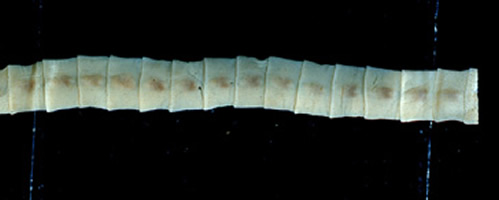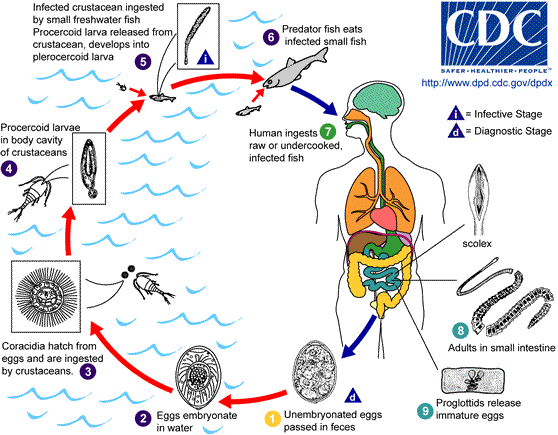Diphyllobothrium
| Diphyllobothrium | ||||||||||||||
|---|---|---|---|---|---|---|---|---|---|---|---|---|---|---|
 Proglottids of D. latum
| ||||||||||||||
| Scientific classification | ||||||||||||||
| ||||||||||||||
| Species | ||||||||||||||
|
D. latum |
Template:DiseaseDisorder infobox
|
WikiDoc Resources for Diphyllobothrium |
|
Articles |
|---|
|
Most recent articles on Diphyllobothrium Most cited articles on Diphyllobothrium |
|
Media |
|
Powerpoint slides on Diphyllobothrium |
|
Evidence Based Medicine |
|
Clinical Trials |
|
Ongoing Trials on Diphyllobothrium at Clinical Trials.gov Trial results on Diphyllobothrium Clinical Trials on Diphyllobothrium at Google
|
|
Guidelines / Policies / Govt |
|
US National Guidelines Clearinghouse on Diphyllobothrium NICE Guidance on Diphyllobothrium
|
|
Books |
|
News |
|
Commentary |
|
Definitions |
|
Patient Resources / Community |
|
Patient resources on Diphyllobothrium Discussion groups on Diphyllobothrium Patient Handouts on Diphyllobothrium Directions to Hospitals Treating Diphyllobothrium Risk calculators and risk factors for Diphyllobothrium
|
|
Healthcare Provider Resources |
|
Causes & Risk Factors for Diphyllobothrium |
|
Continuing Medical Education (CME) |
|
International |
|
|
|
Business |
|
Experimental / Informatics |
Please Take Over This Page and Apply to be Editor-In-Chief for this topic: There can be one or more than one Editor-In-Chief. You may also apply to be an Associate Editor-In-Chief of one of the subtopics below. Please mail us [1] to indicate your interest in serving either as an Editor-In-Chief of the entire topic or as an Associate Editor-In-Chief for a subtopic. Please be sure to attach your CV and or biographical sketch.
Overview
Diphyllobothrium is a genus of tapeworm best known for causing the infection Diphyllobothriosis . The principal species causing diphyllobothriosis is Diphyllobothrium latum, known as the broad or fish tapeworm, or broad fish tapeworm. D. latum is the longest tapeworm in humans, averaging ten meters long. Adults can shed up to a million eggs a day. D. latum is a pseudophyllid cestode that infects fish and mammals. It is morphologically very similar to other members of the genus Diphyllobothrium, but can sometimes be distinguished by host. Even this is not always possible, as there have been twelve other species of this genus reported to infect humans, especially Diphyllobothrium dendriticum (the salmon tapeworm), which has a much larger range (the whole northern hemisphere). D. latum is native to Scandinavia, western Russia, and the Baltics, though it is now also present in North America, especially the Pacific Northwest.
In Canada, the most common infecting species is D. nihonkaiense, which was only identified as a separate species from D. latum in 1989.[1]
In adults, proglottids are usually relatively wide (hence the name broad tapeworm). As in all pseudophyllid cestodes, the genital pores open midventrally.
Several other Diphyllobothrium species have been reported to infect humans, but less frequently; they include D. pacificum, D. cordatum, D. ursi, D. lanceolatum, D. dalliae, and D. yonagoensis.
Life cycle

Adult tapeworms may infect humans, canids, felines, bears, pinnipeds, and mustelids, though the accuracy of the records for some of the nonhuman species is disputed.
Immature eggs are passed in feces of the mammal host (the definitive host, where the worms reproduce). Under appropriate conditions, the eggs mature (in approximately 18 to 20 days) and yield oncosphere larvae which develop into coracidia (ciliated larvae). After ingestion by a suitable freshwater crustacean such as a copepod (the first intermediate host) the coracidia develop into procercoid larvae. Following ingestion of the copepod by a suitable second intermediate host, typically a minnow or other small freshwater fish, the procercoid larvae are released from the crustacean and migrate into the fish's flesh where they develop into a plerocercoid larvae (sparganum). The plerocercoid larvae are the infective stage for the definitive host (including humans).
Because humans do not generally eat undercooked minnows and similar small freshwater fish, these do not represent an important source of infection. Nevertheless, these small second intermediate hosts can be eaten by larger predator species, for example, trout, perch, and walleyed pike. In this case, the sparganum can migrate to the musculature of the larger predator fish and mammals can acquire the disease by eating these later intermediate infected host fish raw or undercooked. After ingestion of the infected fish, the plerocercoids develop into immature adults and then into mature adult tapeworms which will reside in the small intestine. The adults attach to the intestinal mucosa by means of the two bilateral grooves (bothria) of their scolex. The adults can reach more than 10 m (up to 30 m) in length in some species such as D. latum, with more than 3,000 proglottids. Immature eggs are discharged from the proglottids (up to 1,000,000 eggs per day per worm) and are passed in the feces. Eggs appear in the feces 5 to 6 weeks after infection. The tapeworm can live up to 20 years.
Geographic distribution
Diphyllobothriasis occurs in areas where lakes and rivers coexist with human consumption of raw or undercooked freshwater fish. Such areas are found in the Northern Hemisphere (Europe, newly independent states of the former Soviet Union (NIS), North America, Asia) (particularly in Japan (because of Sushi or Sashimi)), Uganda, Peru (because of Ceviche) Chile.
Around mid-twentieth in Japan before advancements in refrigeration, many sushi/sashimi connoisseurs suffered great morbidity and mortality from Diphyllobothrium after eating unrefrigerated sashimi. After developments in parasitology, many scientists came to realise that the primary cause for this burden was due to the relatively favourable parasite breeding conditions that raw fish offered.
Clinical features
Diphyllobothriasis can last for decades if untreated. Most infections are asymptomatic. Manifestations may include abdominal discomfort, diarrhea, vomiting and weight loss. Vitamin B12 deficiency with subsequent megaloblastic anemia may occur, but has not for several decades in D. latum infections, possibly because of improved nutrition. In one test, nearly half of the ingested vitamin was absorbed by D. latum in otherwise healthy patients, while 80-100% was absorbed by the worm in patients with anemia. It is not known why anemia occurs in some cases but not others. Massive infections may result in intestinal obstruction. Migration of proglottids can cause cholecystitis or cholangitis.
cases are not reported, unlikely due to the higher likelihood for them to be involved in meal preparation, rather than any morphological differences.
Diagnosis
Microscopic identification of eggs in the stool is the basis of specific diagnosis. Eggs are usually numerous and can be demonstrated without concentration techniques. Examination of proglottids passed in the stool is also of diagnostic value.
Diagnostic tool:
- Microscopy
- Morphologic comparison with other intestinal parasites
Though it is difficult to identify the eggs or proglottids to the species level, the distinction is of little medical importance because, like most adult tapeworms in the intestine, all members of this genus respond to the same drugs.
Treatment
Praziquantel and niclosamide are pistorical treatments that should no longer be used as first line therapy in developed countries; they result in destruction and disintegration of the worm which may make it impossible to confirm that the scolex (head of the worm) has been passed (the only way to confirm cure). Praziquantel or niclosamide should only be used in situations when endoscopy is not available or is not possible.
The preferred treatment for all tapeworm infections is injection of diatrizoic acid into the duodenum, which causes the worm to detach and be passed whole.[2]
Prevention
Avoid ingestion of raw freshwater fish. Adequate cooking or freezing of freshwater fish will kill the encysted fish tapeworm larvae. Also, because human feces is an important mechanism for spreading eggs, proper disposal of sewage can cut down on infection of fish and thus of humans.
References
- http://www.dpd.cdc.gov/dpdx/HTML/Diphyllobothriasis.htm
- Roberts, Larry S. and Janovy, John Jr. Gerald D. Schmidt and Larry S. Roberts' Foundations of Parasitology, Seventh edition. 2005.
- ↑ Lou YS, Koga M, Higo H; et al. (1989). "A human infection of the cestode, Diphyllobothrium nihonkaiense". Fukuoka Igaku Zasshi. 80: 446&ndash, 50.
- ↑ Waki K, Oi H, Takahashi S; et al. (1986). "Successful treatment of Diphyllobothrium latum and Taenia saginata infection by intraduodenal 'Gastrografin' injection". Lancet. 2: 1124&ndash, 6.
de:Fischbandwurm id:Cacing pita ikan nl:Vislintworm fi:Lapamato sv:Binnikemask